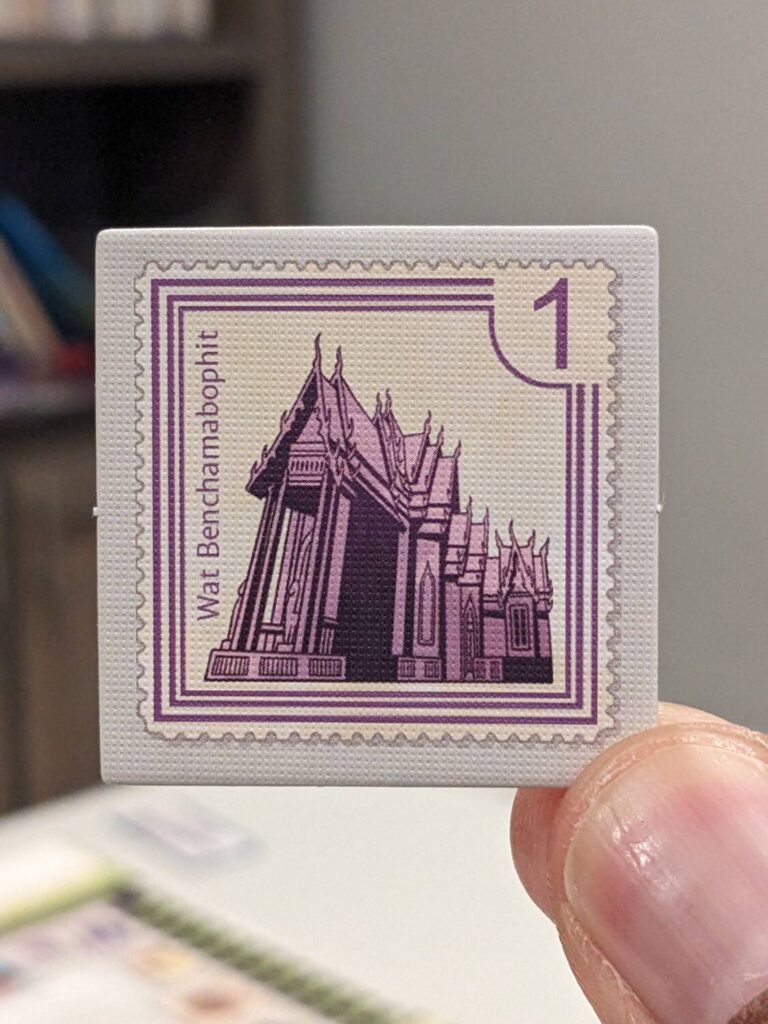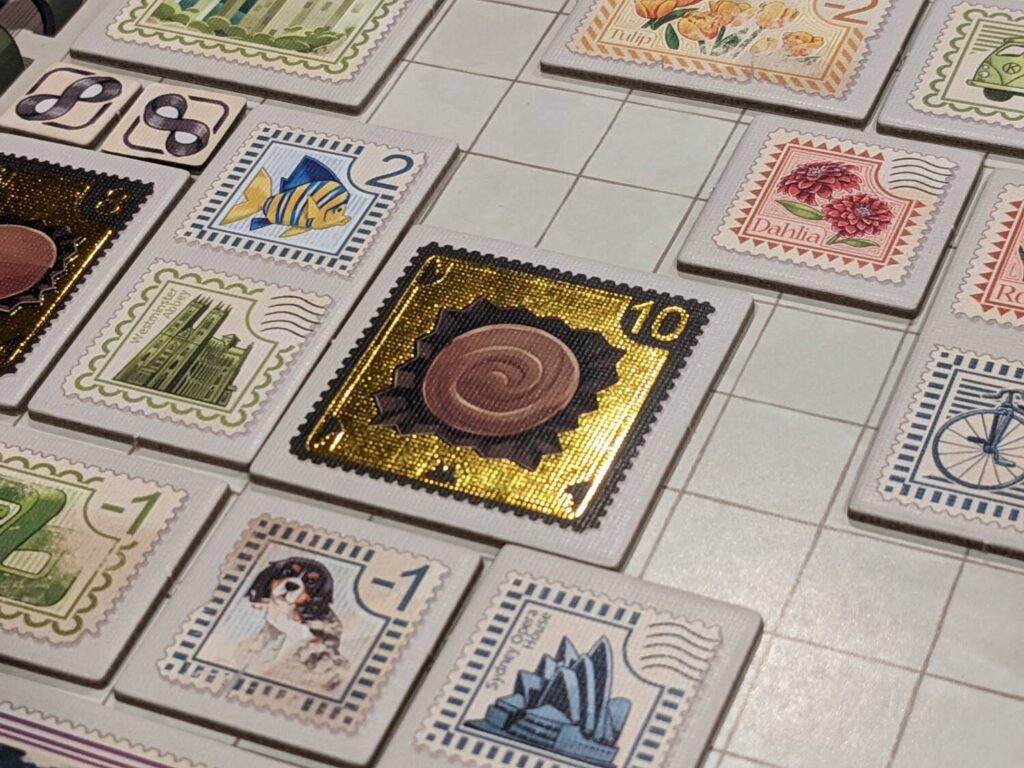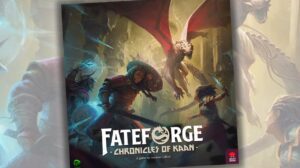Disclosure: Meeple Mountain received a free copy of this product in exchange for an honest, unbiased review. This review is not intended to be an endorsement.
There was a point during my second multiplayer game of Stamp Swap (2024, Stonemaier Games) where I felt a tinge of sadness.
You see, I’ve had the distinct pleasure of playing not one, but two stamp games in the course of about a year…Stamp Swap, and one other game. That other game is a lot easier to table, features better components, is quicker to teach, and plays in a much shorter duration than the other. That other game? Penny Black (2023, Buffalo Games).
The sadness was simple. “Sorry, but Penny Black is just better than Stamp Swap,” said my buddy Rex after we wrapped up that second multiplayer game of Stamp Swap.
I had to agree, to the point where I went to start up a game of Penny Black…only to realize that I had given away my copy to another guy in my review group, like most of the review copies I receive from publishers.
Stamp Swap isn’t a bad game, and it works best at its highest player count of five. The main negatives: it takes anywhere from an hour to 90 minutes with 4-5 players (too long for a quick tile-laying game), and it’s not as strong of a production as one has come to expect with Stonemaier’s other games. That led to some strange moments, like when a guy called out the flimsy stamp notebook player mats, or when multiple players complained about the themes of certain stamps in the display.

We Cut, We Choose
Stamp Swap is an “I Cut, You Choose” game, similar to games as varied as The Great Split and San Marco, a game I covered in my Dusty Euro series. The main mechanic, and the best thing about Stamp Swap, is the end of the game’s first of three phases in each round.
In Stamp Swap, 1-5 players are stamp collectors trying to score the most points. This is done through an array of conditional scoring elements, objectives that are shared by all players but scored individually at the end of each round. That leads to plenty of competition for the best stamps, each of which are added to a general pool during setup.
Stamps of varying sizes, along with “Attendee” cards which can alter the rules for the card’s owner, are added to a general swap area. Then, players spend the first phase of a round, “Collect”, drafting six total items—stamps and Attendee cards—from the pool, one at a time, in turn order.
After all items are drafted—some of which are face-up stamps or cards showing their theme and color, with remaining stamps laid out face-down—players must reserve one of their six items then cut the rest into two piles. Each pile must have at least one item, meaning piles have to be split into groups of either one and four items, or two and three. Opposing players will have the chance to take one of your non-reserve piles, so you want to build a juicy offer for opponents while also ensuring you can get the stamps you need when scoring happens in phase three of each round.
In my five-player game of Stamp Swap, the cut step was plenty of fun. (Strangely, there is not a separate “Cut” phase. Cutting takes place during the Collect phase, but I would have either called the first phase “Collect and Cut” or just called out a fourth phase, simply called “Cut.” Maybe this is why I don’t design board games.)

Some of the Attendee cards also have nice benefits, and their powers are active for whoever is currently holding those cards. Because the Attendee cards are later placed into one half of the swap pile (unless a player decides to use their reserve action that round to keep the card instead), it was interesting to find ways to use the Attendee powers even once to earn bonus stamps or advantages when cutting piles.
After the Collect phase, players move to the Swap phase. Shopping (which is essentially what the Swap phase is) for a pile is fun as the first player in a larger player count game, since you have a lot of choices. But as players snatch up piles, those going later in turn order have fewer available piles to choose from. By the end of the Swap phase, choices are usually made for you since there are limited piles to add to your own.
Then players take their winnings and quietly place their stamps in their notebook, a simple cardboard player mat. The choice of using a standard sheet of cardboard to serve as the notebook was an interesting one, because it doesn’t stop a player’s stamps from jostling around when a player inevitably knocks a previously-placed stamp out of place. Ditto for when someone accidentally bumps the table, knocking stamps slightly out of position.
Of course, nicer components equate to higher prices, and Stamp Swap is already teetering on the precipice of “nope, too expensive”…the MSRP for this game is around $40. So, that means you’ll get handsome, well-drawn stamp tiles, and a few other touches, such as the linen finish on the two rulebooks.
But the player mats just don’t work. This is one of the few times, if ever, I’ve had a complaint about a Stonemaier production from a component perspective.
Games of Stamp Swap end after three rounds. Players tally up scores from their first three rounds, then add points for a shared end-game condition as well as the individual points listed on each of the stamps drafted into a player’s collection notebook. That has led to a very wide range in scores, from the 90-to-170-point range, depending on how well players aligned with the scoring conditions.

I Cut, Then We Chose the Other Stamp Game
Stamp Swap was fine. It didn’t offend, nor did it set the world on fire. In fact, for the gamers in my groups who had not played Penny Black, Stamp Swap was interesting and got above-average reviews from the players who were new to stamp collection board games.
But for any of us who HAD played Penny Black, Stamp Swap was no contest.
The one thing that stood out, even to the players who liked Stamp Swap more than I did, was the game length. Our five-player game took about 80 minutes. With three players (me and my two kids), the game took about 45 minutes. That’s a better place to land on a game that is so straightforward.
Even seven-player games of The Great Split are a 30-minute affair. Sure—same mechanic, different theme—but in the case of both games, the main area of excitement comes during the cutting and choosing phases. The rest is just administration, and games like The Great Split get the administration part right.
Another issue? During the Collect phase, players must huddle around a small pool of even smaller stamps to make their picks. In part, that’s because the images led to tough calls regarding the theme of each stamp. From across a large table, flowers (one of the game’s five themes) are easy to pick out. Animals? Again, generally quite easy.
But space, monuments, and vehicle themes were a little harder. In our five-player game, we got physically close together to pick stamps, so close that I thought I was cheating on my wife. (Stamp Swap would not have been a good pick for early COVID game nights, capiche?)

This is another area where Penny Black got things right. The stamps don’t mess with mixing themes with colors…all red stamps had a price (from 1-5 cents), and those prices were very easy to read, even across a large table. Also, the tile build was exceptional in that game…bakelite makes for sexy tiles, and it was just satisfying to handle and place those tiles. Tac-”tile” satisfaction, overall, felt like less of a thing with the tiles from Stamp Swap.
Stamp Swap does have a solo mode, which gives it an edge over Penny Black if you are looking at playing this one alone. The solo mode (designed, as always from Stonemaier, by the Automa Factory) is a little more complicated than the rules for the main game, thanks to an appraisal system that had me wishing my wife would just sit down to play a two-player version of the game.
The solo is a little strange—three difficulty levels are available, but it’s just easier to use the intro mode, which scores 120 points at the end of the game for the automa, and you can more easily pick out stamps that the bot will snatch each turn. I played solo once on normal (level two of three), and lost 137-115. It wasn’t nearly as interesting as the five-player game, and even with three players, I enjoyed Stamp Swap less than I did at five players.
The swap phase is just better with more players. If you haven’t played Penny Black and can get a larger group to the table, Stamp Swap is worth a look…otherwise, this one is a pass.












Add Comment